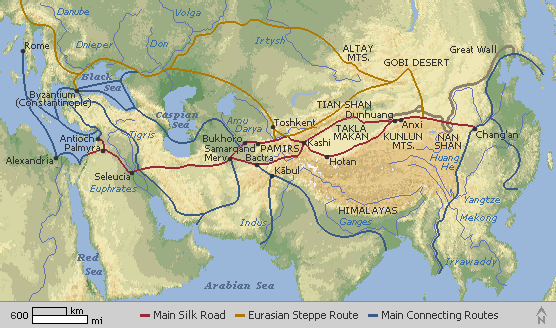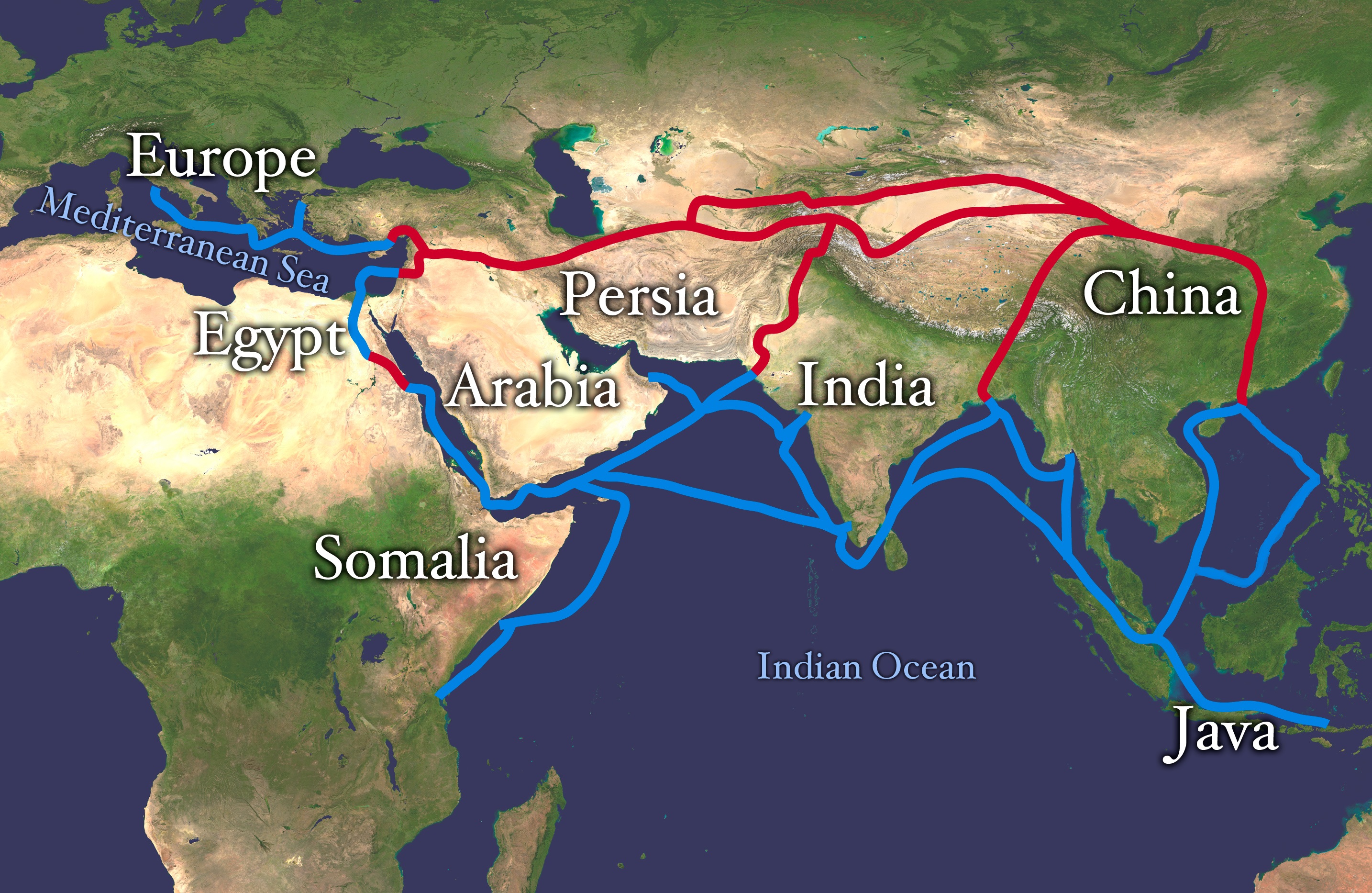Effects of the Silk Road on Classical India
These are spread across seven states in India Bihar Jammu and Kashmir Maharashtra Puducherry Punjab Tamil Nadu and Uttar. Like the merchants of the overland Silk Road those who traveled along this route were also at the mercy of the forces of nature especially storms that were highly unpredictable.

Pin On Margaret Travis Silk Road
Silk went westward and wools gold and silver went east.

. Silk owing to its soft texture and appealing shimmer became so hotly desired that it was used as currency in central Asia. Silk Road in Medieval Times. Effects on Indian Economy India was perhaps the most prominent and critical factor for the success of ancient silk route owing to its rich civilisation proximity to China and as a geographical.
The present study focuses on the trade links of India with ancient Silk Roads through Karakoram Pass in western Himalaya with two fold objective First to understand the cultural geography and traditional society of the western Himalaya which has been changed beyond expectation. The Sild Road spread and built upon the ideas of Buddhism and Islam during the post classical era making it a Cultural Bridge bewteen Asia and Europe. Additionally Buddhism Zoroastrianism Manichaeism and Nestorianism were all introduced to China and parts of India because of the Silk Roads influence.
They also traded diseases plants and animals along the route. Religious beliefs of the peoples of the Silk Road changed radically over time and was largely due to the effects of travel and trade on the Silk Road itself. The effects of exchange One obvious effect of trade along the Silk Road was more goods were available in more places.
Routes of the Silk Road To the east of Merv the routes are especially challenging and unpredictable. Cultural interaction was a vital aspect of material exchange. The Silk Road splits into northern and southern routes to cross the great Taklamakan Desert and the high passes of the Tian Shan Mountains before they arrive in Merv.
Silk Road - Marco Polo. The Silk Road. China also received Nestorian Christianity and Buddhism from India via the Silk Road.
You will be supplied with a map of the Silk Road by your instructor. All these factors significantly affected the people and cultures that lived along the route. On a practical level merchants had to learn the languages and customs of the countries they travelled through in order to negotiate successfully.
The desert routes follow the best paths from one oasis to the next. The people traded luxury goods as well as ideas religions art culinary delicacies and musical traditions. Some research suggests that the Black Death which devastated Europe in the late 1340s CE likely spread from Asia along the Silk Road.
2 The Silk Road allowed the spread of religions see chart above such as Nestorian ChristianityManichaeism Zoroastrianism and Buddhism. Different forms of music and the various instruments used to create it spread beyond its regions of origin accompanying people as they moved along the Silk Roads. Silk Road also called Silk Route ancient trade route linking China with the West that carried goods and ideas between the two great civilizations of Rome and China.
The Silk Road Routes was a route that was established in order to increase trade of silk paper and other goods across China India and Central East Asia. Many merchants missionaries and travellers have used this road for traveling and trading from one end to another. Silk Road in Classical Antiguity.
Smallpox and measles devastated the populations of both empires contributing to their political collapse 323 The Silk Road connected the Roman Empire to the Han Dynasty however with the communication of the two empires the disease traveled with them along with the deaths of. For over two thousand years the Silk Road was a network of roads for the travel and dissemination of religious beliefs across Eurasia. Fruits food plants animals and farming techniques exchange involved in the silk road trading enabled peasants from Han to acquire new skills and knowledge about farming and planting.
Effects of the Silk Road on Classical India 1 The Silk Road at first caused many pastoral groups to form. In 1515 the. 3 The stirrup spread though out the Silk Road.
Peasants were able to bring up new agricultural commodities to Han society promoting the agricultural economy of Han. Trade along the so-called Silk Road economic belt included fruits and vegetables livestock grain leather and hides tools religious objects artwork precious stones and metals andperhaps more. Diseases also traveled along the Silk Road.
Not only did the Silk Road enhance the exchange of goods and innovations but also the spread of religion. Second documentation of common archaeological sites and monuments along the silk trade. Strands of silk have been found in ancient Egypt from about 1000 BCE but these may be of Indian rather than Chinese origin.
The spread of papermaking was also influenced by the route. Indeed many musical instruments that were common in Silk Roads regions were very flexible. The religious beliefs of people along the Silk Road at the beginning of the 1st century BCE were very.
Any discussion of the Silk Route- at least in the Indian context- turns up a laundry list of inconsequential vacuous knowledge. Silk Road sites in India are sites that were important for trade on the ancient Silk Road. In 1498 the Cape of Good Hope route to India was discovered.
Textiles spices and even religions were all exchanged along the Silk Road starting around 1000 BC. Moreover pirates who plied the oceans were also a threat to travelers just as the desert bandits were for their overland counterparts. The Age of Exploration gave rise to faster routes between the East and West but parts of the Silk Road continued to be critical pathways among varied cultures.
In turn those travelling along the Silk Roads absorbed the different musical influences of the regions in which they travelled. Whilst the trade and travel there was a multicultural transmission between China and India. And continuing for several millenniums.
Islams Influence on the Silk Roads Known as the Silk Road this vast expanse of intercultural trade routes traversed Eurasia from the Mediterranean all the way to Japan crossing into India on the way. This production method spread from China through much of central Asia as a direct result of the route itself. One obvious effect of trade along the Silk Road was more goods were available in more places.
Eventually rich families did settleand build large establishments. Evidence of trade in ancient Chinese silk has been found in archaeological excavations in Central Asian Bactria currently the region around Balkh and Mazar-i-Sharif Afghanistan dating to about 500 BCE.

How The Buddha Got His Face The New York Times

Trade Routes 1st Century Ad History Geography History Historical Maps
Long Distance Trade Along The Silk Roads Silk Roads And The Fall Of Rome And Han

The Silk Road Article Khan Academy

The Silk Road Article Khan Academy

Map From Stratfor Showing The Various Main Trade Routes Across Central Asia Comprising The Silk Road Silk Road Map Silk Road China

The Silk Road Overland And Maritime Routes The Overland And Maritime Download Scientific Diagram

India And The Silk Roads The History Of A Trading World By Jagjeet Lally

How Did Geography Influence The Development Of Civilization In Ancient China Ancient China Lessons Ancient History Lessons Middle Ages Lessons

History Of The Tea Trade The Silk Road Heavenly Tea Leaves Blog

How Big A Role Did Ancient India Play On The Silk Road Quora







Comments
Post a Comment